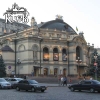Национальная опера Украины
Строительство Киевской оперы было завершено в 1901. Одно из роскошнейший театральных зданий мира - шедевр немецкого архитектора В. Шретера исполненный в формах «французского ренессанса», украшенный масками и мерам, скульптурами грифонов и муз. В разные годы здесь выступали Б. Гмыря, О. Петрусенко, Е. Мирошниченко, А. Кочерга, гастролировали П. Чайковский, С. Рахманов, Ф. Шаляпин.
Здесь бывал Игнаци Падеревский, работали хореограф Бронислава Нижинская, певец Стефан Беллина-Скупевский и другие. Игнаци Ян Падеревский – пианист, композитор, государственный и общественный деятель. С молодых лет стал известен как испольнитель виртуоз. В 1899 пребывал в Киеве, еще раз посетил город в 1901 году, когда в Киевской опере провели премьеру его оперы «Манру».
- Памятник - Князю Ярославу Мудрому
- Золотые Ворота
- Памятник - Грушевскому М.С.
- Здание библиотеки университета Шевченко
- Женский пансион Левашовой
- Колокольня Софії Київської
- Софийский собор
- Государственный центр театрального искусства им. Леся Курбаса
- Фундамент Десятинной церкви
- Дом, в котором работал Януш Корчак
